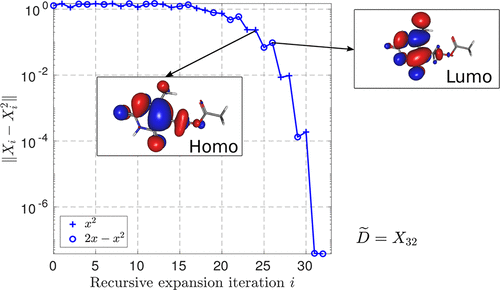当前位置:
X-MOL 学术
›
J. Chem. Theory Comput.
›
论文详情
Our official English website, www.x-mol.net, welcomes your
feedback! (Note: you will need to create a separate account there.)
On-the-Fly Computation of Frontal Orbitals in Density Matrix Expansions
Journal of Chemical Theory and Computation ( IF 5.7 ) Pub Date : 2017-12-20 00:00:00 , DOI: 10.1021/acs.jctc.7b00968 Anastasia Kruchinina 1 , Elias Rudberg 1 , Emanuel H. Rubensson 1
Journal of Chemical Theory and Computation ( IF 5.7 ) Pub Date : 2017-12-20 00:00:00 , DOI: 10.1021/acs.jctc.7b00968 Anastasia Kruchinina 1 , Elias Rudberg 1 , Emanuel H. Rubensson 1
Affiliation

|
We propose a method for computation of frontal (homo and lumo) orbitals in recursive polynomial expansion algorithms for the density matrix. Such algorithms give a computational cost that increases only linearly with system size for sufficiently sparse systems, but a drawback compared to the traditional diagonalization approach is that molecular orbitals are not readily available. Our method is based on the idea to use the polynomial of the density matrix expansion as an eigenvalue filter giving large separation between eigenvalues around homo and lumo [Rubensson et al. J. Chem. Phys. 2008, 128, 176101]. This filter is combined with a shift-and-square (folded spectrum) method to move the desired eigenvalue to the end of the spectrum. In this work we propose a transparent way to select recursive expansion iteration and shift for the eigenvector computation that results in a sharp eigenvalue filter. The filter is obtained as a byproduct of the density matrix expansion, and there is no significant additional cost associated either with its construction or with its application. This gives a clear-cut and efficient eigenvalue solver that can be used to compute homo and lumo orbitals with sufficient accuracy in a small fraction of the total recursive expansion time. Our algorithms make use of recent homo and lumo eigenvalue estimates that can be obtained at negligible cost [Rubensson et al. SIAM J. Sci. Comput. 2014, 36, B147]. We illustrate our method by performing self-consistent field calculations for large scale systems.
中文翻译:

密度矩阵展开式中的额叶轨道的实时计算
我们提出了一种用于密度矩阵的递归多项式展开算法中的正面(同质和LUMO)轨道的计算方法。对于足够稀疏的系统,此类算法的计算成本仅随系统大小线性增加,但与传统对角化方法相比,其缺点是分子轨道不易获得。我们的方法基于这样的思想,即使用密度矩阵展开式的多项式作为特征值过滤器,从而使均值和亮度周围的特征值之间有较大的分离[Rubensson等。J.化学。物理 2008年,128,176101]。该滤波器与移位和平方(折叠频谱)方法结合使用,以将所需的特征值移动到频谱的末端。在这项工作中,我们提出了一种透明的方法来选择递归展开迭代和移位,以进行特征向量计算,从而得到清晰的特征值滤波器。过滤器是密度矩阵膨胀的副产品,因此,与其构造或应用无关,也没有任何明显的额外成本。这提供了一种清晰有效的特征值求解器,该求解器可用于在总递归展开时间的一小部分中以足够的精度计算同位和亮度轨道。我们的算法利用了可以以可忽略的成本获得的最近的均值和亮度特征值估计[Rubensson等。暹罗科学 电脑。2014,36,B147]。我们通过对大型系统执行自洽场计算来说明我们的方法。
更新日期:2017-12-20
中文翻译:

密度矩阵展开式中的额叶轨道的实时计算
我们提出了一种用于密度矩阵的递归多项式展开算法中的正面(同质和LUMO)轨道的计算方法。对于足够稀疏的系统,此类算法的计算成本仅随系统大小线性增加,但与传统对角化方法相比,其缺点是分子轨道不易获得。我们的方法基于这样的思想,即使用密度矩阵展开式的多项式作为特征值过滤器,从而使均值和亮度周围的特征值之间有较大的分离[Rubensson等。J.化学。物理 2008年,128,176101]。该滤波器与移位和平方(折叠频谱)方法结合使用,以将所需的特征值移动到频谱的末端。在这项工作中,我们提出了一种透明的方法来选择递归展开迭代和移位,以进行特征向量计算,从而得到清晰的特征值滤波器。过滤器是密度矩阵膨胀的副产品,因此,与其构造或应用无关,也没有任何明显的额外成本。这提供了一种清晰有效的特征值求解器,该求解器可用于在总递归展开时间的一小部分中以足够的精度计算同位和亮度轨道。我们的算法利用了可以以可忽略的成本获得的最近的均值和亮度特征值估计[Rubensson等。暹罗科学 电脑。2014,36,B147]。我们通过对大型系统执行自洽场计算来说明我们的方法。










































 京公网安备 11010802027423号
京公网安备 11010802027423号